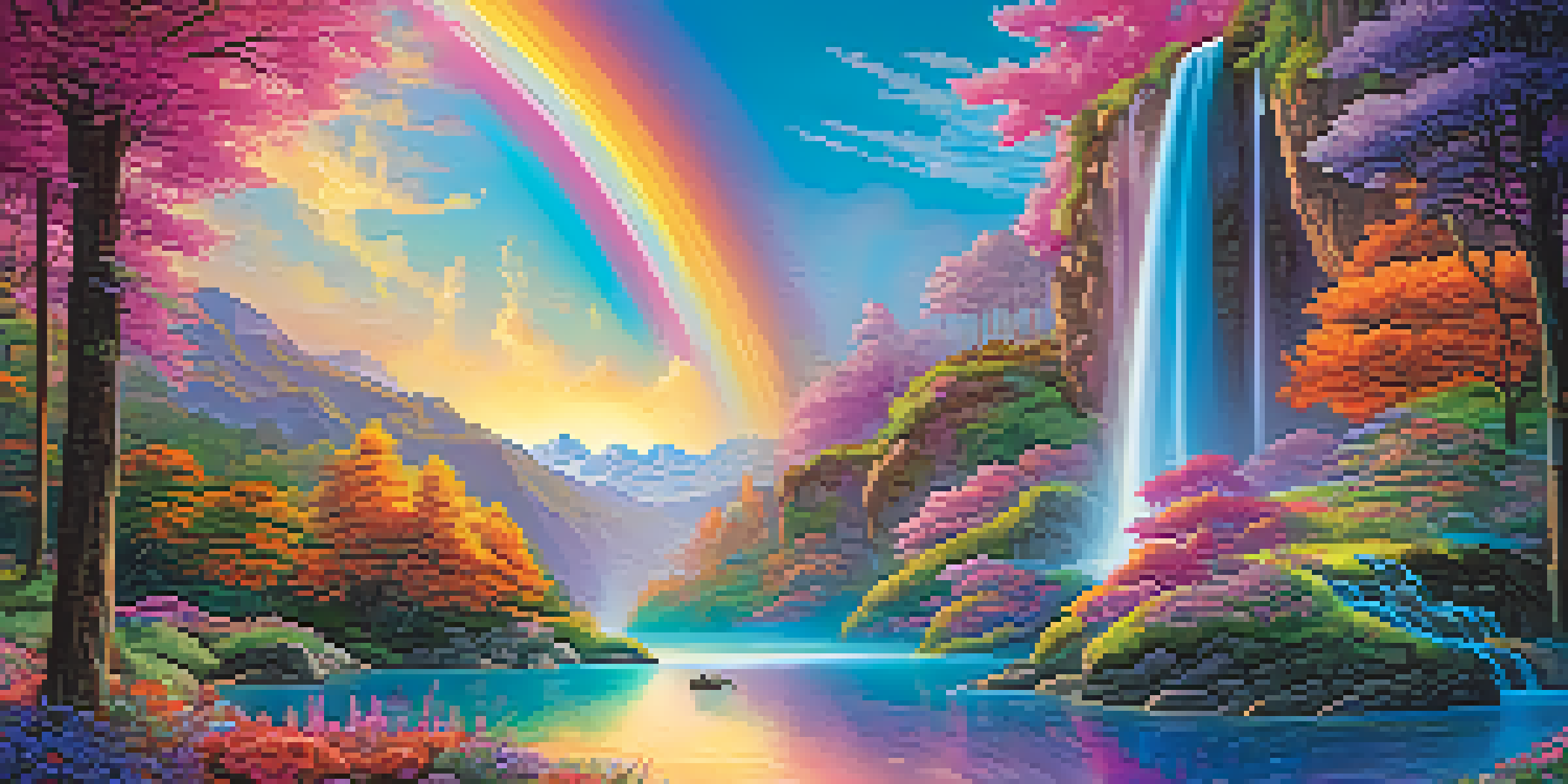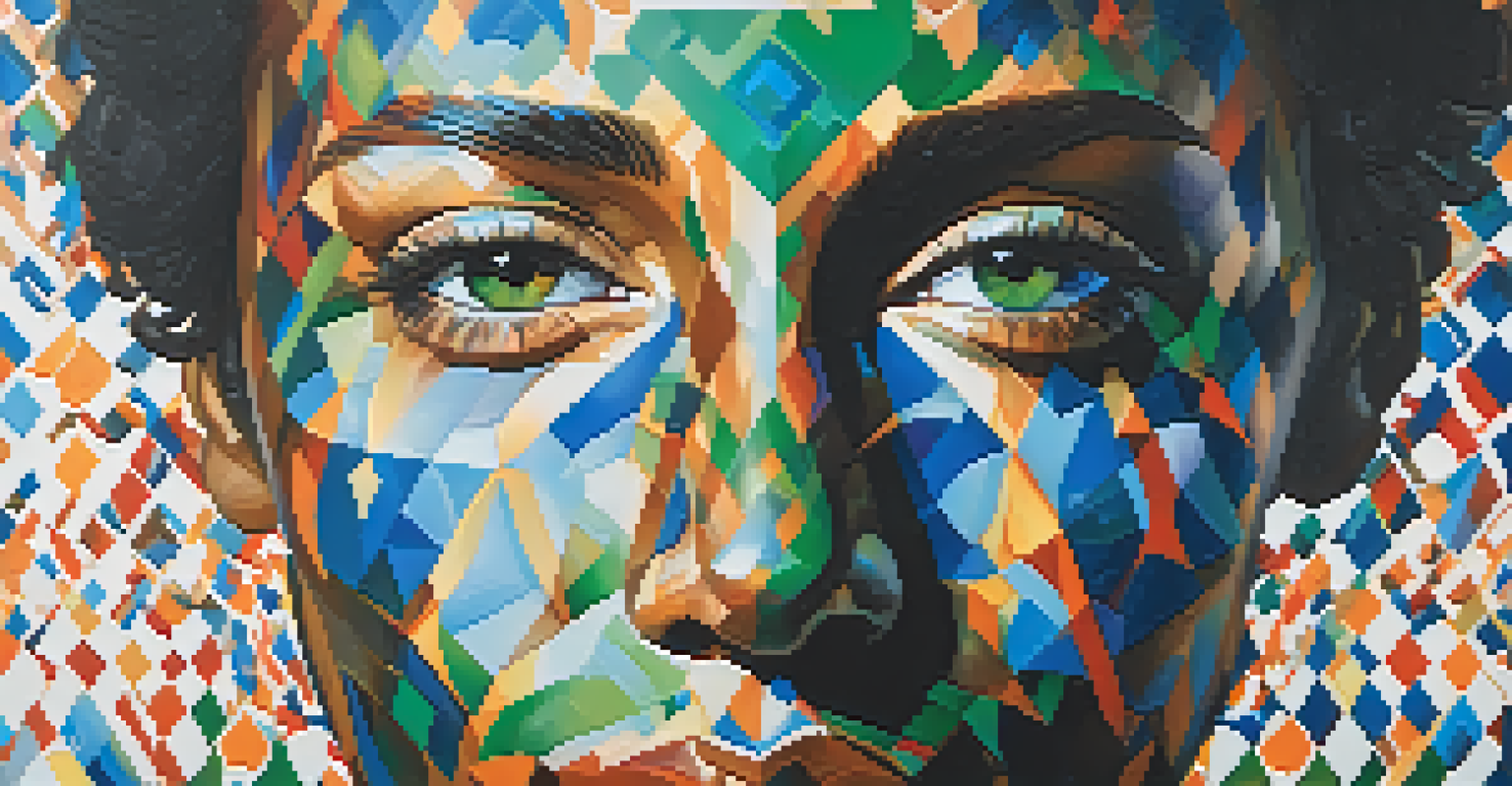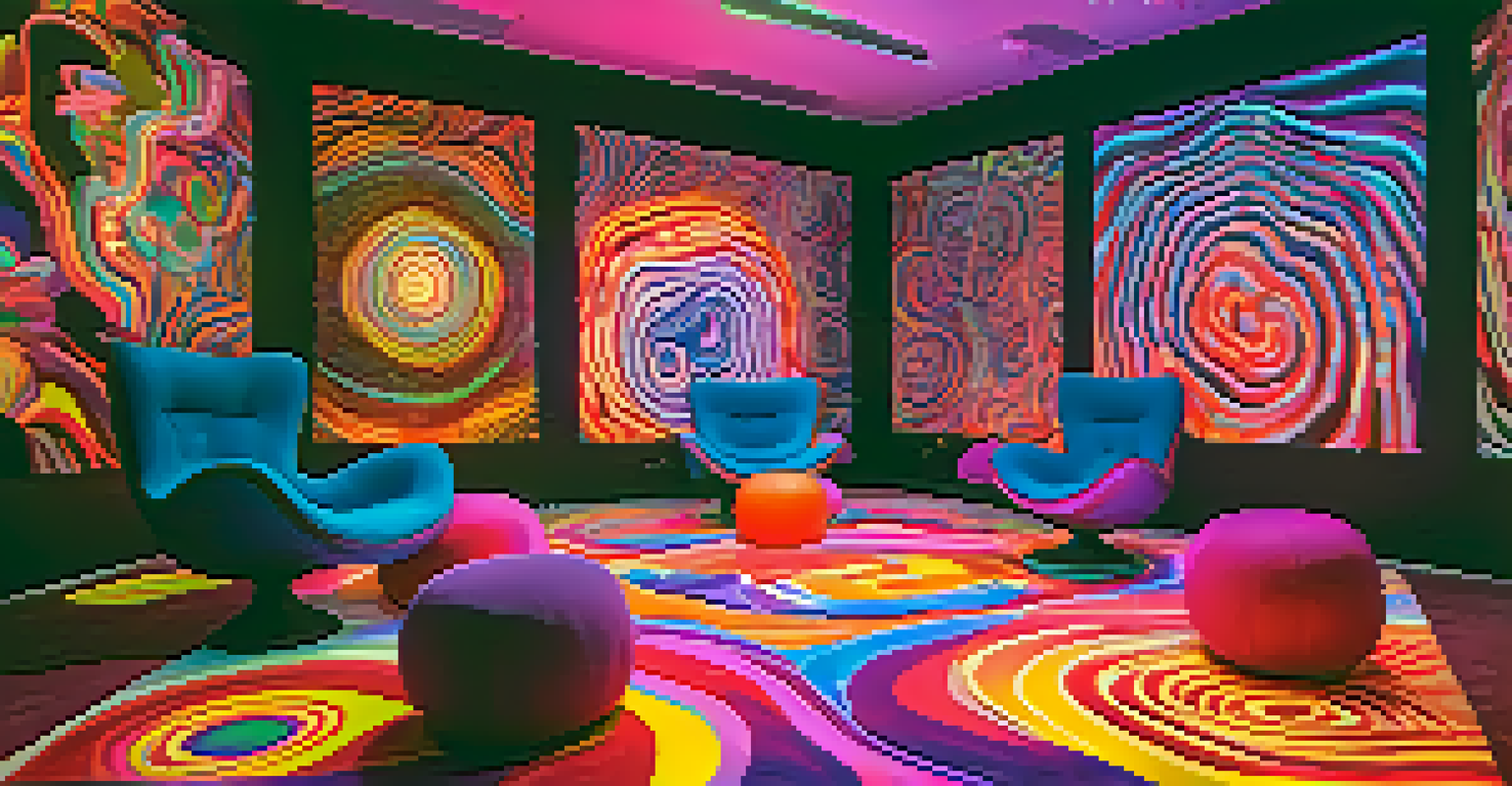Psychedelic Aesthetics: Entheogens in the Art World Today

Defining Psychedelic Aesthetics in Art
Psychedelic aesthetics refer to the visual and conceptual styles inspired by altered states of consciousness, often linked to the use of entheogens. These substances, like psilocybin mushrooms and LSD, have historically influenced artistic expression by altering perception and creativity. Artists often draw upon vibrant colors, intricate patterns, and surreal imagery to evoke the feelings associated with these experiences.
Psychedelics can help us to see the world in a different way, revealing the interconnectedness of all things.
In contemporary art, psychedelic aesthetics can be seen across various mediums, from painting and sculpture to digital art and installations. These works invite viewers to experience a sense of wonder and exploration, often challenging traditional notions of reality. By embracing such styles, artists connect with audiences on a deeper, more emotional level, encouraging an introspective journey.
Moreover, the resurgence of interest in psychedelics due to recent research highlighting their therapeutic benefits has opened new avenues for artists. As society begins to re-evaluate its relationship with these substances, the artistic expression surrounding them evolves, bringing forth innovative interpretations and dialogues.
The Role of Entheogens in Creative Processes
Entheogens, substances that are believed to facilitate spiritual experiences, have long been used by artists to enhance creativity. Many famous artists, including painters and musicians, have credited their creative breakthroughs to the use of psychedelics. For instance, the Beatles famously experimented with LSD, leading to groundbreaking music that still resonates today.

When artists engage with these substances, they often report experiencing heightened imagination and vivid inspiration. This can result in unique artistic expressions that break away from conventional forms, pushing boundaries in ways that standard creative processes may not. The interplay between the psyche and the creative process becomes a rich landscape for exploration and innovation.
Psychedelic Aesthetics in Art
Psychedelic aesthetics in art draw upon vibrant colors and surreal imagery to evoke altered states of consciousness.
In today's fast-paced world, where mental health is a growing concern, many are revisiting the potential of entheogens as tools for enhancing creativity. This exploration can lead to a more profound understanding of oneself and the world, fostering richer artistic expressions and experiences that resonate with broader audiences.
Contemporary Artists Embracing Psychedelic Themes
Numerous contemporary artists are infusing psychedelic themes into their work, showcasing the profound impact of entheogens on modern art. Artists like Alex Grey, known for his intricate, visionary paintings, embody this trend by exploring the intersection of spirituality and psychedelia. His work invites viewers to delve into the realms of consciousness, often depicting interconnectedness and transcendence.
The creative process is not a linear one. It's more of a spiral, a dance between inspiration and the unknown.
Moreover, artists like Takashi Murakami incorporate elements of psychedelia into their vibrant, pop-culture-infused artworks. His playful style and use of bright colors resonate with the psychedelic experience, making it accessible and engaging for viewers. Such artists not only celebrate the aesthetic but also challenge societal norms about mental health and perception.
These artists are not just creating visually striking works; they are also sparking conversations around the benefits and implications of psychedelics in society. Through their art, they encourage audiences to question their own perceptions and explore the deeper meanings behind their experiences.
Psychedelic Art in Popular Culture
Psychedelic aesthetics have permeated popular culture, influencing everything from music videos to fashion. The vibrant colors and surreal visuals commonly associated with psychedelic art have become a staple in contemporary design, making their way into advertisements, album covers, and even social media. This widespread adoption reflects a collective fascination with the transcendent and the extraordinary.
For example, music festivals like Coachella and Burning Man often feature psychedelic art installations that enhance the overall experience for attendees. These environments foster a sense of community and shared exploration, allowing participants to immerse themselves in an artistic journey. The connection between music, art, and altered states of consciousness creates an unforgettable atmosphere.
Entheogens Enhance Creativity
Entheogens are believed to enhance creativity, with many artists attributing their breakthroughs to these substances.
As popular culture continues to embrace these aesthetics, it also normalizes discussions around mental health and the potential benefits of entheogens. This shift may lead to a broader acceptance of these themes in art, creating a rich dialogue about creativity, spirituality, and self-exploration.
The Intersection of Psychedelics and Therapy
Recent studies have shown that entheogens can aid in therapeutic contexts, offering new insights into mental health treatment. This emerging field has caught the attention of artists exploring the connections between these substances and emotional healing. By infusing their work with themes of therapy and introspection, artists can create a powerful narrative around the healing potential of psychedelics.
Art therapy, in particular, benefits from incorporating psychedelic elements, allowing individuals to express their thoughts and feelings in innovative ways. By exploring altered states, participants often find new perspectives on their struggles, leading to cathartic experiences. This therapeutic aspect of art can foster a sense of community and understanding among those who have been affected by mental health challenges.
As the stigma surrounding psychedelics diminishes, artists who engage with these themes can help reshape public perception. Their work serves as a bridge, connecting the worlds of art, therapy, and spirituality, promoting a holistic understanding of healing and creativity.
The Future of Psychedelic Aesthetics in Art
The future of psychedelic aesthetics in art is both exciting and unpredictable, as societal attitudes toward entheogens continue to evolve. With increasing research backing the therapeutic potential of these substances, artists are likely to push boundaries even further. This could lead to a renaissance of creativity, where psychedelics play a central role in shaping the artistic landscape.
As more artists experiment with these themes, we can expect a diverse range of expressions that challenge conventional norms. The integration of technology, such as virtual reality and digital media, may also amplify the psychedelic experience, creating immersive environments that transport viewers into new realms of consciousness. This innovation could redefine how art is experienced and understood.
Therapeutic Potential of Psychedelics
Recent studies suggest that entheogens can aid in therapy, fostering emotional healing and self-exploration through art.
Ultimately, the continued exploration of psychedelic aesthetics in art invites us to question our perceptions of reality and expand our understanding of creativity. As artists delve into these themes, they offer a glimpse into the profound connection between art, consciousness, and the human experience.
Conclusion: Embracing the Psychedelic Journey
In conclusion, psychedelic aesthetics offer a unique lens through which we can explore creativity, healing, and the human experience. As artists continue to engage with entheogens, their work reflects a growing acceptance of these themes in contemporary society. This journey not only enriches the art world but also encourages broader conversations about mental health and spirituality.
The intersection of art and psychedelics invites us to reconsider our perceptions and embrace the beauty of altered states of consciousness. As we navigate this evolving landscape, we can find inspiration in the vibrant expressions that emerge from these experiences. The ongoing dialogue surrounding psychedelic aesthetics promises to shape the future of art in exciting ways.

Ultimately, embracing the psychedelic journey allows us to connect with ourselves and others on a deeper level. By appreciating the artistry inspired by these experiences, we can foster a greater understanding of the transformative power of creativity and the human spirit.